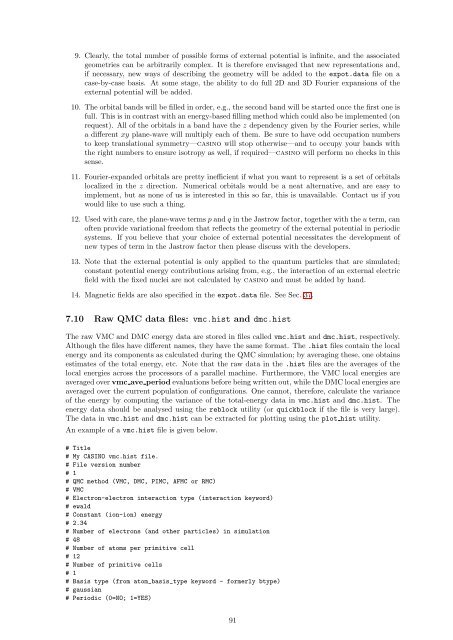CASINO manual - Theory of Condensed Matter
CASINO manual - Theory of Condensed Matter
CASINO manual - Theory of Condensed Matter
Create successful ePaper yourself
Turn your PDF publications into a flip-book with our unique Google optimized e-Paper software.
9. Clearly, the total number <strong>of</strong> possible forms <strong>of</strong> external potential is infinite, and the associated<br />
geometries can be arbitrarily complex. It is therefore envisaged that new representations and,<br />
if necessary, new ways <strong>of</strong> describing the geometry will be added to the expot.data file on a<br />
case-by-case basis. At some stage, the ability to do full 2D and 3D Fourier expansions <strong>of</strong> the<br />
external potential will be added.<br />
10. The orbital bands will be filled in order, e.g., the second band will be started once the first one is<br />
full. This is in contrast with an energy-based filling method which could also be implemented (on<br />
request). All <strong>of</strong> the orbitals in a band have the z dependency given by the Fourier series, while<br />
a different xy plane-wave will multiply each <strong>of</strong> them. Be sure to have odd occupation numbers<br />
to keep translational symmetry—casino will stop otherwise—and to occupy your bands with<br />
the right numbers to ensure isotropy as well, if required—casino will perform no checks in this<br />
sense.<br />
11. Fourier-expanded orbitals are pretty inefficient if what you want to represent is a set <strong>of</strong> orbitals<br />
localized in the z direction. Numerical orbitals would be a neat alternative, and are easy to<br />
implement, but as none <strong>of</strong> us is interested in this so far, this is unavailable. Contact us if you<br />
would like to use such a thing.<br />
12. Used with care, the plane-wave terms p and q in the Jastrow factor, together with the u term, can<br />
<strong>of</strong>ten provide variational freedom that reflects the geometry <strong>of</strong> the external potential in periodic<br />
systems. If you believe that your choice <strong>of</strong> external potential necessitates the development <strong>of</strong><br />
new types <strong>of</strong> term in the Jastrow factor then please discuss with the developers.<br />
13. Note that the external potential is only applied to the quantum particles that are simulated;<br />
constant potential energy contributions arising from, e.g., the interaction <strong>of</strong> an external electric<br />
field with the fixed nuclei are not calculated by casino and must be added by hand.<br />
14. Magnetic fields are also specified in the expot.data file. See Sec. 37.<br />
7.10 Raw QMC data files: vmc.hist and dmc.hist<br />
The raw VMC and DMC energy data are stored in files called vmc.hist and dmc.hist, respectively.<br />
Although the files have different names, they have the same format. The .hist files contain the local<br />
energy and its components as calculated during the QMC simulation; by averaging these, one obtains<br />
estimates <strong>of</strong> the total energy, etc. Note that the raw data in the .hist files are the averages <strong>of</strong> the<br />
local energies across the processors <strong>of</strong> a parallel machine. Furthermore, the VMC local energies are<br />
averaged over vmc ave period evaluations before being written out, while the DMC local energies are<br />
averaged over the current population <strong>of</strong> configurations. One cannot, therefore, calculate the variance<br />
<strong>of</strong> the energy by computing the variance <strong>of</strong> the total-energy data in vmc.hist and dmc.hist. The<br />
energy data should be analysed using the reblock utility (or quickblock if the file is very large).<br />
The data in vmc.hist and dmc.hist can be extracted for plotting using the plot hist utility.<br />
An example <strong>of</strong> a vmc.hist file is given below.<br />
# Title<br />
# My <strong>CASINO</strong> vmc.hist file.<br />
# File version number<br />
# 1<br />
# QMC method (VMC, DMC, PIMC, AFMC or RMC)<br />
# VMC<br />
# Electron-electron interaction type (interaction keyword)<br />
# ewald<br />
# Constant (ion-ion) energy<br />
# 2.34<br />
# Number <strong>of</strong> electrons (and other particles) in simulation<br />
# 48<br />
# Number <strong>of</strong> atoms per primitive cell<br />
# 12<br />
# Number <strong>of</strong> primitive cells<br />
# 1<br />
# Basis type (from atom_basis_type keyword - formerly btype)<br />
# gaussian<br />
# Periodic (0=NO; 1=YES)<br />
91

















